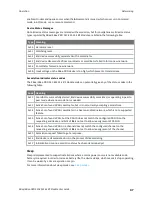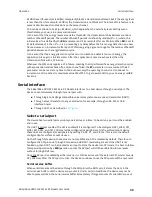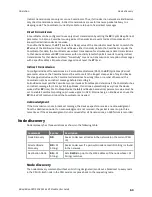
Operation
Sleep support
XBee/XBee-PRO S2C 802.15.4 RF Module User Guide
60
I/O line passing details
The same message is received for both I/O sampling and for I/O line passing. But I/O line passing only
occurs if
IA
matches the short or long address of the sending node or if
IA
is 0xFFFF to match a
sample from any node. The default value of
IA
is 0xFFFFFFFF, which prevents I/O line passing from
occurring on the node because no node has that address. Additionally, the receiving device must have
a matching value for output. For example, if an ADC0 sample is received, then
P0
must be configured
with 2 for PWM output. Otherwise, the analog signal will not be reflected with a matching PWM signal.
Likewise, if the sample indicates that D2 is high, but
D2
is not set to 4 or 5 on the receiving device,
then the D2 pin will not be affected by I/O line passing.
When a digital output pin is set to something different than its configured value, that pin may return to
its configured value after the time specified for the corresponding timer.
T0
specifies how long D0 will
hold its non-configured value and
T1
specifies how long D1 will hold its non-configured value. A value of
0xFF indicates that a pin holds the value of the input of the corresponding device indefinitely and a
value less than 0xFF specifies how many tenth second units the pin holds the non-configured value.
For PWM outputs, PT timer applies to both PWM0 and PWM1. A value of 0xFF allows the PWM pin to
output a duty cycle reflective of the analog input indefinitely and a smaller value indicates how many
10th second units before PWM output reverts to the duty cycle specified by
M0
or
M1
.
Output control
The
IO
(Digital Output Level) command controls the output levels of D0 through D7 that are configured
as output pins (either 4 or 5). These values override the configured output levels of the pins until they
are changed again (the pins do not automatically revert to their configured values after a timeout.)
You can use the
IO
command to trigger a sample on change detect.
Sleep support
Set
bit 1 to suppress automatic wake-up sampling.
When a device wakes, it always performs a sample based on any active ADC or DIO lines. This allows
sampling based on the sleep cycle whether it be Cyclic Sleep (
SM
= 4 or 5) or Pin Sleep (
SM
= 1). Set
the
parameter to gather more samples when awake.
For Cyclic Sleep modes: If the
IR
parameter is set, the device stays awake until the
parameter is met. The device stays awake for
.
Sleep modes
Sleep modes enable the device to enter states of low-power consumption when not in use. In order to
enter Sleep mode, one of the following conditions must be met (in addition to the device having a non-
zero
SM
parameter value):
n
SLEEP_RQ/DTR (pin 9 on through-hole devices, pin 10 on surface-mount devices) is asserted
and the device is in a pin sleep mode (
SM
= 1, or 5)
n
The device is idle (no data transmission or reception) for the amount of time defined by the
ST
(Time before Sleep) parameter.
Note
ST
is only active when
SM
= 4 or 5.
The following table shows the sleep mode configurations.
















































